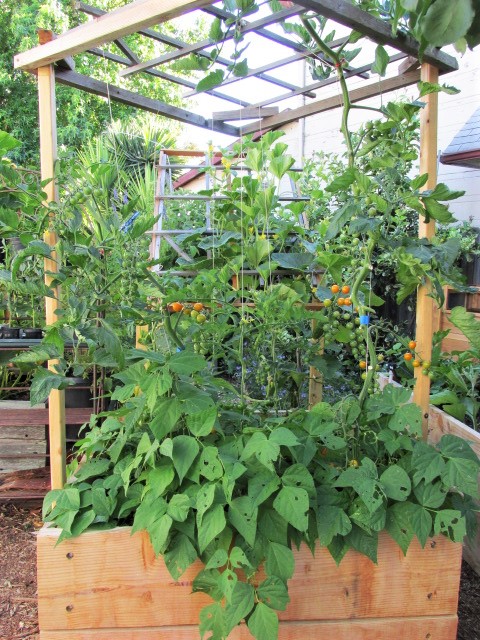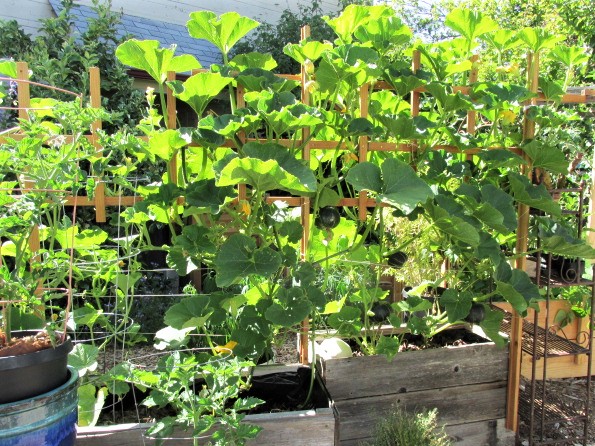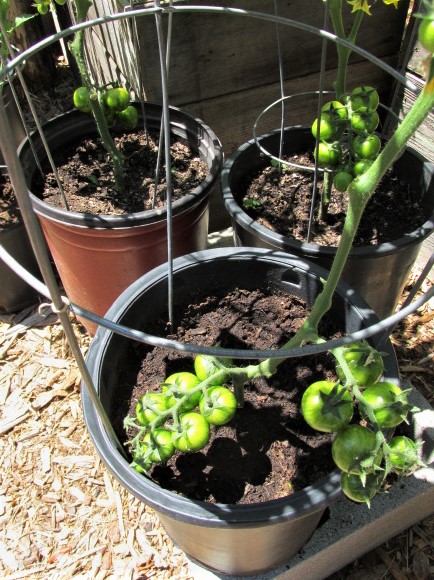by Fey Adelstein
Like many people this spring, I was inspired to upgrade my garden. I started with the construction of raised beds 2ft in height (to alleviate my concerns about unknown soil conditions). The sides of the beds are framed, creating strength from which to anchor a trellis. Before filling the beds with soil, I lined the insides and bottoms of the beds w 6mm plastic – punching multiple holes in the bottom of the plastic for drainage. Into the beds went a mix of retail organic soil, compost, and amendments such as worm castings, chicken manure, oyster shell, kelp, crab meal, rock phosphate (for tomatoes), and Epsom salts (for cucumbers). I topped my beds with a thick layer of leaf mulch.
Trellis designs and materials can vary a lot. The first consideration is what type of plants are going to use the support. This year I planted the same crops I grew in previous years – but I decided to grow them in a more vertical fashion, supported by trellises.
Overhead Trellis for Growing Tomatoes on a Line
I chose an Overhead Trellis for growing tomatoes on a single vine. A line is run down from the overhead structure. This line is staked to the stem and then carefully wound around the vine a few times for support (don’t snap off the top of the plant!). Keeping only the main vine, I remove all the suckers. Once the tomato plants are mature, the leaves are frequently pruned, beginning with the lowest leaves first. As the vine grows taller, it will need additional attachments to the line (I re-use those wire ties that you find around veggies at the market). As the plant matures, I prune leaves to create airflow and open up the space below for compatible plantings. At the base of my tomatoes this year I am growing Bush Beans, Genovese Basil, and Holy Basil. The Holy Basil flowers bloom early and are very attractive to bees. Thanks to the bees, I note 100% pollination of the tomatoes. (I am growing Sun Gold cherry and Black Zebra cherry – the same varieties that I grew last year). Most surprising to me is to see how this heavy pruning produces larger fruits!
Basic Lath Trellis to Support Squash
To support squash we made a heavy duty Basic Lath Trellis by ripping 2” strips from redwood fence boards (Economy Lumber). The “legs” of the trellis are doubled to hold the weight of the plants. On this trellis I am growing Black Forest Kabocha squash (requires tying).
Sloped Trellis for Cucumbers
I use basic cedar wood trellises (available from Home Depot) to support cucumbers. This year I pruned the cucumber plants to their main vine. And as the cucumber plants matured, I first removed the lower leaves and then later I began thinning out some of other leaves to allow for airflow. Compared to the tomato plants, this pruning of the cucumber plants is not so drastic, but it helps keep the plant tidy, and it opens some room for plants below. I have planted beets and chard at the base of my trellised cucumber plants.
Alternatives to Raised Beds
Growing Tomatoes in Containers and Squash in Soil Sacks
Tomatoes will grow in three, five and seven gallon containers (seven gallon is ideal) with cages inserted into the container for support. I add a bit of organic fertilizer to these container plantings. I am also growing squash out of the plastic sacks that I bought retail garden soil in (approx one to two cubic feet). I punched holes in the bottom of the sacks for drainage. These containers and sacks are pretty portable up until the plants get really big. These containers and sacks work really well, keep in mind that they generally require frequent watering.
Growing vertically this season has helped me to re-evaluate my garden space. It’s helped me to plan according to sun exposure and think more about airflow. I look forward to further experimentation.




